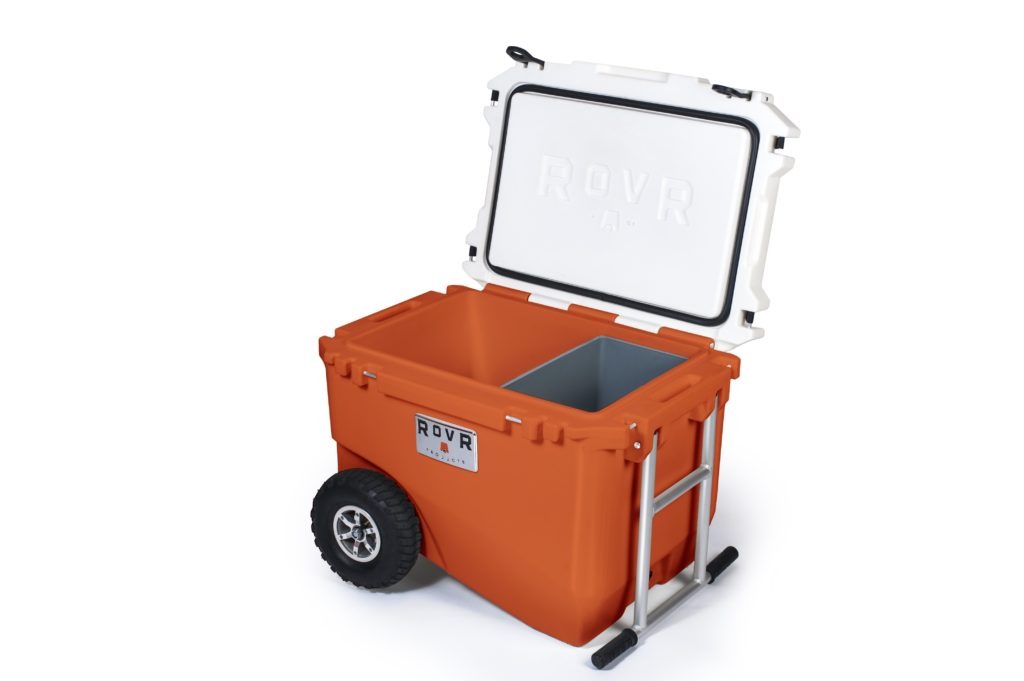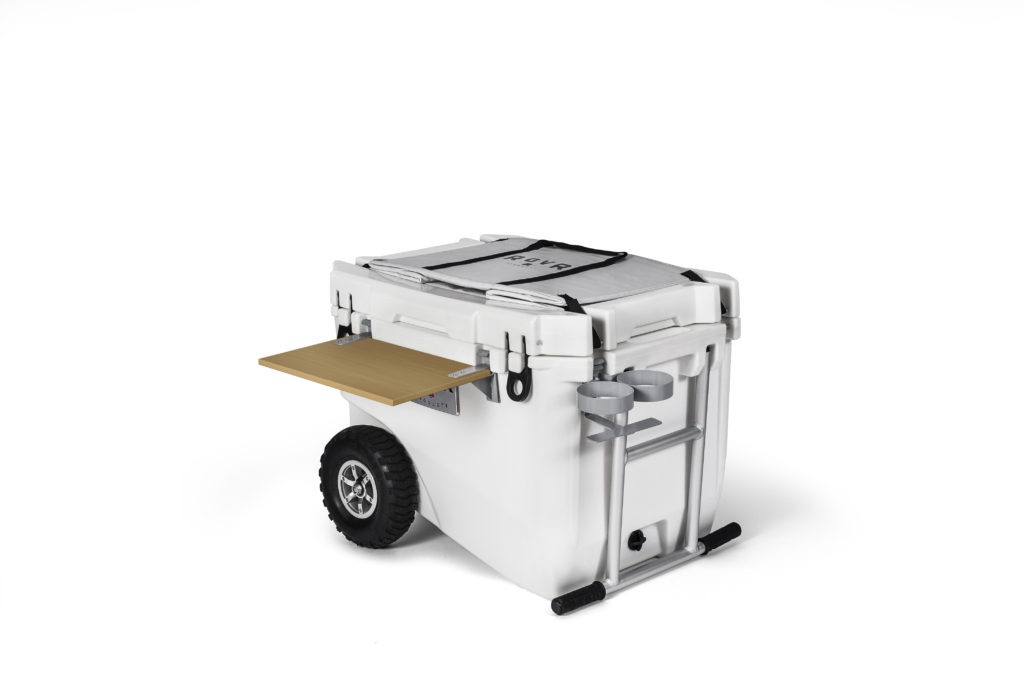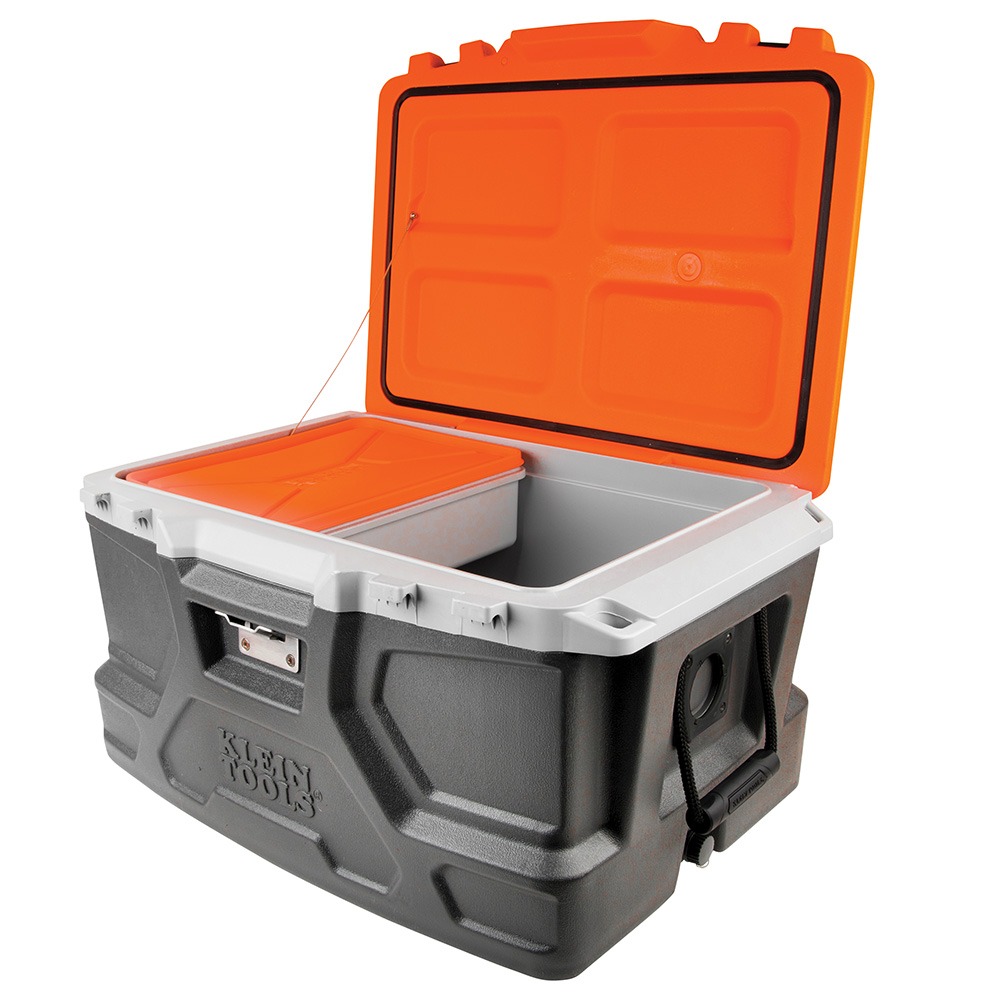Quench Jobsite Thirst with this Year’s Toughest Coolers
Words: Cass Stern
Words: Cassandra Stern
Photos: Rovr, Klein Tools,
Quench Jobsite Thirst with this Year’s Toughest Coolers
Words: Cassandra Stern
Photos: Rovr, Klein Tools,
Coolers today are a household staple. From youth soccer games to family day at the beach, camping, cookouts, picnics and more, it is difficult to imagine these events without ice-cold drinks and fresh sandwiches. According to a report from the Grand View Research firm, which specializes in market trend analysis, “the global camping cooler market size was valued at USD $621.8 million in 2017” and is projected to grow 6.4% annually until 2025.
While the outdoor recreation market is a leading cooler consumer, the construction market is an often overlooked audience whose rigorous and demanding profession often requires working outdoors, often in extremely hot conditions for an extended period of time. Thanks in no small part to “better technologies used for manufacturing lightweight chillers that can retain ice for a longer duration,” the versatile portable cooler has been a game-changer for tradesmen like masons, and “will contribute to market growth over the coming years.”
However, the iconic cooler you’re picturing hasn’t been around as long as you would think— although the need for one certainly has. Refrigeration techniques date back well into 17-1800 BC- but the traditional portable cooler was not developed and patented until 1951! In order to understand how the refrigeration process evolved into the portable coolers used today, it is important to first appreciate the invention and popularity of the icebox. Invented in 1802 by American farmer and cabinetmaker Thomas Moore, the first icebox was created to transport butter on the long journey from farm to market, allowing Moore to serve his customer's firm bricks rather than the soft tubs of butter being sold by his competitors.
An instant success, the icebox was soon a staple fixture in many American homes and was soon being used around the world. Iceboxes were typically lined with zinc or tin and then insulated with a variety of materials, and were kept cool with blocks of ice stored in a large compartment in the top of the box. As warm air rises, the cool air is displaced to the lower portion of the box, keeping the perishables below fresh. In order to prevent the melting ice from dripping down, saturating and ruining the food beneath it, systems were put in place to divert the water flow.
While higher-end models featured a spigot or spout for the melting ice water to run through, most iceboxes were equipped with a drip pan that needed to be emptied manually at least once a day. As a result, relying on drying, salting, curing, canning, or otherwise preserving food items, food could be reliably kept safer and fresher for much longer than ever before- which would change people’s lives (and their eating habits) forever.
Unfortunately, the sheer size and weight of the average icebox made traveling with it very difficult, and while a bucket of ice bucket usually did the trick, the ice never seemed to last. Thus, the portable cooler was born. Patented in 1951 by Richard C. Laramy of Joliet, Illinois, the idea did not gain much traction initially. A few years later, in 1954, the Coleman company acquired Laramy’s patent and improved on the initial design with a galvanized skin for tougher durability. Later, Coleman would coin the word “cooler” in a series of advertising campaigns that would eventually land one in almost every American home, eventually mass-producing the iconic Coleman cooler of our childhoods.
Today, there are dozens, if not hundreds of cooler brands with models that feature everything from the typical wheels and cup holders to cutting boards and more. With such a large variety of available options, it can be difficult to select the best model for its intended purpose. For mason contractors on a job site where one of the greatest challenges is staying properly hydrated throughout the workday, a rugged cooler that can survive the rigors of a worksite is absolutely essential. Thankfully, there are several models available today that can stand up to even the most demanding conditions, keeping masons (and their beverages) cool as ice.
Rovr RollR 60

A small company based around a big idea, Rovr was founded in 2016 to provide consumers with the toughest cooler products on the market. Today, the RollR cooler series boasts the most standard features of any cooler currently available, and the rotomolded body, puncture-proof wheels, and aluminum handles come standard on all size options. This Colorado company formed to serve the outdoor recreational community, but their rugged products are perfectly suited for the rigorous demands of the construction market as well.
The Rovr RollR 60 is designed to comfortably keep 60 quarts of food and beverages cool for 7-10 days and is said to be bear-proof. One of the most popular features of the RollR 60 is the two high-performance puncture-resistant tires, which could be an excellent option for any job site. The 9-inch tires are designed to work smoothly on any terrain and are mounted on five-spoke aluminum hubs for greater durability. The RollR 60’s “rotomolded, elevated body with an airtight gasket and thick foam insulation” coupled with the deepfreeze dry bin makes storing and organizing food and drinks for the entire crew simple and efficient.

Additionally, aluminum pull-beside dual handles allow users of the RollR 60 even greater control around tricky worksite obstacles. Finally, the Rovr RollR 60 includes a foldable pop-up wagon bin for any additional odds and ends- for masons, this could be a place to store anything from spare twigs and slides to car keys and sunglasses, and can easily be stowed away when not in use. The RollR 60 can even be fitted with fun accessories like cup holders (for a slow day), and even a cutting board!
Tradesman Pro™ Tough Box Cooler, 48-Quart
Founded in 1857, the Klein family has been manufacturing and providing American construction workers and companies with expertly designed and crafted tools and equipment designed to make the worksite safer and work more efficient. For the past 150 years, Klein Tools has remained “the only major tool manufacturer worldwide focused on electrical and utility applications. No other manufacturer of hand tools and related products used in electrical applications makes more items in America than Klein Tools.”

The Tradesman Pro™ Tough Box Cooler definitely lives up to its name with its durable, high-quality materials. With a 48-quart capacity capable of keeping 72 cans or 40 bottles cool for up to 30 hours, the Tough Box Cooler would be ideal for the hotter workdays. The design features a “separate, removable plastic container [that] keeps items dry and slides on [the] top ledge for easy access underneath,” and the sealing gasket keeps the cold where it belongs, assisted by the heavy-duty rubber latches which keep the bright orange lip sealed shut.
Additional features include a leak-resistant drain that allows excess water to be emptied without tipping, a no-rust stainless steel hinged lid kept upright with stainless steel wire, and tie-down ropes with textured grip handles for easy transport. There are also optional features you can choose from like the Twist-Lock Klein LED Work Light or Wireless Speaker on side mounts. Sitting down for lunch? The Tough Box Cooler has one more surprise: seating capacity of up to 300 pounds.
Coleman 70 Quart Coastal Xtreme Series Marine Cooler
As consumers we aren’t strangers to the name Coleman, founded by William Coffin Coleman in the 1900’s, a gas pressure light salesman. The company has certainly come a long way creating an array of products from lamps to campsite cooktops, camping furniture, and of course coolers and drinkware. But for our guys the best products for a jobsite would be their variety of coolers.
From the brand that started it all comes the Coleman 70 Quart Coastal Xtreme Series Marine Cooler. Designed with UVGuard™ material, the Marine Cooler is protected from the sun’s damaging rays while keeping food and beverages cool for up to 5 days (in temperatures up to 90°F). “Xtreme® technology uses an insulated lid and extra insulation in the walls for longer ice retention,” and the 70-quart capacity can hold up to 100 cans.
Like the Tradesman Pro™ Tough Box Cooler, the Coleman Marine Cooler also includes a leak-resistant channel that eliminates the needs to tip while draining and the Have-A-Seat™ Lid can support up to 250 lbs. for storage, or a spot to enjoy a quick break, as well as rust-resistant, stainless steel hinges and hardware. The handles has a comfort-grip no-crush design which could make transportation the jobsite simple, and cup holders are molded into the lid for convenient storage.
Igloo Trailmate Journey 70 QT Cooler
Another household name, Igloo was started in a metalworking shop in 1947 that produced metal water coolers, the first all-plastic chest however, wasn’t created until 1962. Igloo is known for making coolers and for both personal and industrial uses. Who doesn’t remember having or seeing those personal coolers or lunchboxes on a jobsite or in the cafeteria during lunch?
The Igloo Trailmate Journey 70 Quart Cooler like the Rovr RollR 60, includes a set of 10 inches, never-flat wheels, which allow the cooler to travel with masons as they work their way through a jobsite and are specifically designed to tackle tough terrain with superior traction. The 70-quart capacity can hold up to 112 12 oz. cans, with up to 4 days of ice retention and the Glide™ Handle’s telescopic, locking horizontal placement is ergonomic and is said to reduce up to 50% of the load resistance.
This model includes a dry storage box that is water-resistant and lockable, which could be good for keeping keys and other valuables safe even while out of sight, as does an included storage pocket. Like others on this list, the Trailmate Journey features stainless steel parts, aluminum construction, and a tip-free drain plug, but has several additional touches like Cool Riser Technology™, which is said to increase cooling performance by keeping the cooler elevated and off of the hot ground below, and Ultratherm, which fully insulated the cooler body for advanced cooling performance.
YETI Tundra 65®
Last but certainly not least: YETI. Founded in 2006, YETI coolers are geared towards the outdoorsman, tailgaters, and barbecue kings. Their products are said to be born out of frustration and molded by experience, these coolers range from smaller soft packed coolers meant for the beach or a day in the park to the rugged hard coolers meant for all things done outside. But can they stand up to the day-to-day hauls of mason contractors? You can be the judge.
The YETI Tundra 65® is one of the most versatile products offered by the YETI brand. The Tundra 65® includes the Fatwall ™ design, which features extra-thick walls holding up to two inches of Permafrost™ insulation, which is “pressure-injected commercial-grade polyurethane foam in the walls and lid” capable of holding 42 12 oz. cans or 52 pounds of ice.
Like the Rovr RollR 60, the Tundra 65® is created with rotomolded construction, making it virtually indestructible and perfectly suited for a rugged worksite. Unlike other coolers, the Tundra 65® utilizes T-Rex™ lid latches with the Neverfail™ hinge system, which features two hinge pins in an interlocking design that eliminates the need for rust-resistant hardware.
Like the Tradesmen Pro™ Tough Box Cooler, the Tundra 65 includes the Interlock™ lid system and Coldlock™ gasket to keep the cold locked in place, as well as the Votex™ tip-free draining system. Add in the Lipgrip™ and DoubleHaul™ handles, and the Tundra 65 may withstand the rigours to any masonry job.
A quality cooler can make a significant difference on a jobsite by making temperature-controlled beverages easily and readily accessible to masons as they work, it ensures that employees will be safer from the dangerous effects of heat and sun. While products and their featured options are numerous, these five products and others like them are a perfect addition to any jobsite, thanks to their tough construction and increased ice retention time.
Additionally, an investment in a rugged cooler for the jobsite eliminates the need to ever use a styrofoam cooler again, saving money and ensuring food and drinks stay colder and fresher longer. Whether you’re considering investing in a high-quality cooler for the first time, or seeking to upgrade your current work cooler, consider checking out models like the Rovr RollR 60 and Tradesmen Pro Tough Box Cooler, or any of the heavy-duty products to see which one could potentially be a fit for your company.